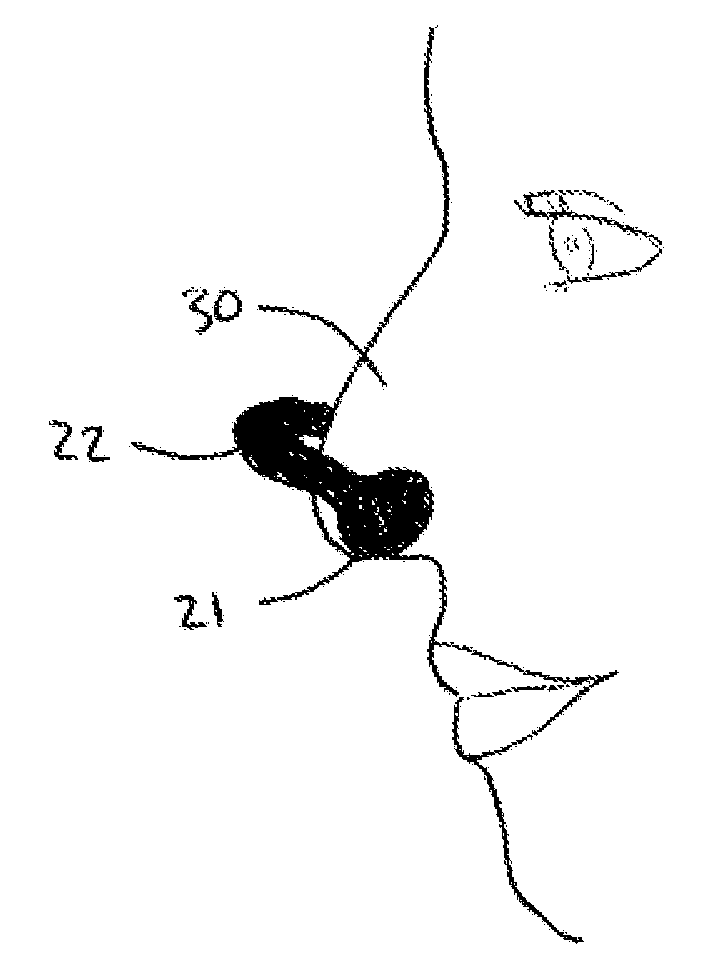Nasal Inspiratory Resistance Trainer
a trainer and inspiratory technology, applied in the field of nasal inspiratory resistance trainers, can solve the problems of increasing the difficulty of nasal breathing, and achieve the effects of increasing the tolerance of carbon dioxide in the body, and increasing the difficulty of nasal breathing
- Summary
- Abstract
- Description
- Claims
- Application Information
AI Technical Summary
Benefits of technology
Problems solved by technology
Method used
Image
Examples
example 1
[0055]A commercially available adjustable nose clip (Speedo Rubber Nose Clip, available from Speedo International Ltd., Nottingham, England), of the type typically utilized while swimming, was used, without any modifications, as the NIRT device in this example. End-tidal carbon dioxide concentration and respiration rate were monitored using a BCI Capnocheck II Hand-held Capnograph.
[0056]Methods: Subjects were seated in a comfortable chair and directed to watch television. The nasal cannula of the sidestream capnograph was taped to the subject's face, and readings were commenced. The capnograph displayed the end tidal carbon dioxide and respiration rate, and the displayed values were recorded at 15 second intervals. After eight minutes, the NIRT was applied to the subject's face, and measurements were again recorded for eight additional minutes, at which time the NIRT was removed, and measurements were again recorded for eight more minutes.
[0057]Results: A pediatric subject (Subject ...
example 2
[0058]A commercially available adjustable nose clip (Speedo Rubber Nose Clip, available from Speedo International Ltd., Nottingham, England) was used, without any modifications, as the NIRT device in this example. End-tidal carbon dioxide concentration and respiration rate were monitored using a BCI Capnocheck II Hand-held Capnograph. A commercially available breathing rate biofeedback device (RESPeRATE®, available from Intercure, Inc., New York, N.Y.) was also used, and affixed to the subject prior to commencement of the experiment.
[0059]The subject, a pediatric subject afflicted with asthma but asymptomatic at the time of the experiment, was seated in a comfortable chair and instructed to read. The tension bands used to monitor respiration in the RESPeRATE unit were applied to the subject. The nasal cannula of the sidestream capnograph was taped to the subject's face, and readings were commenced. End tidal CO2 values were recorded at 15 second intervals. After four minutes, during...
example 3
[0061]A commercially available adjustable nose clip (Speedo Rubber Nose Clip, available from Speedo International Ltd., Nottingham, England), of the type typically utilized while swimming, was used, without any modifications, as the NIRT device in this example. End-tidal carbon dioxide concentration and respiration rate were monitored using a BCI Capnocheck II Hand-held Capnograph.
[0062]Methods: Subjects were seated in a comfortable chair and directed to watch television. The nasal cannula of the sidestream capnograph was inserted into the subject's nostrils, and the tubing was wrapped around the ears to keep the cannula in place. The capnograph displayed the end tidal carbon dioxide and respiration rate, and, after a two-minute acclimation period, the displayed values were recorded at 20 second intervals. After four minutes of recording the values, the NIRT device was applied to the subject's nose, and measurements were recorded for ten additional minutes, at which time the NIRT wa...
PUM
 Login to View More
Login to View More Abstract
Description
Claims
Application Information
 Login to View More
Login to View More - R&D
- Intellectual Property
- Life Sciences
- Materials
- Tech Scout
- Unparalleled Data Quality
- Higher Quality Content
- 60% Fewer Hallucinations
Browse by: Latest US Patents, China's latest patents, Technical Efficacy Thesaurus, Application Domain, Technology Topic, Popular Technical Reports.
© 2025 PatSnap. All rights reserved.Legal|Privacy policy|Modern Slavery Act Transparency Statement|Sitemap|About US| Contact US: help@patsnap.com



